Spiegelung eines Punktes an einer Gerade
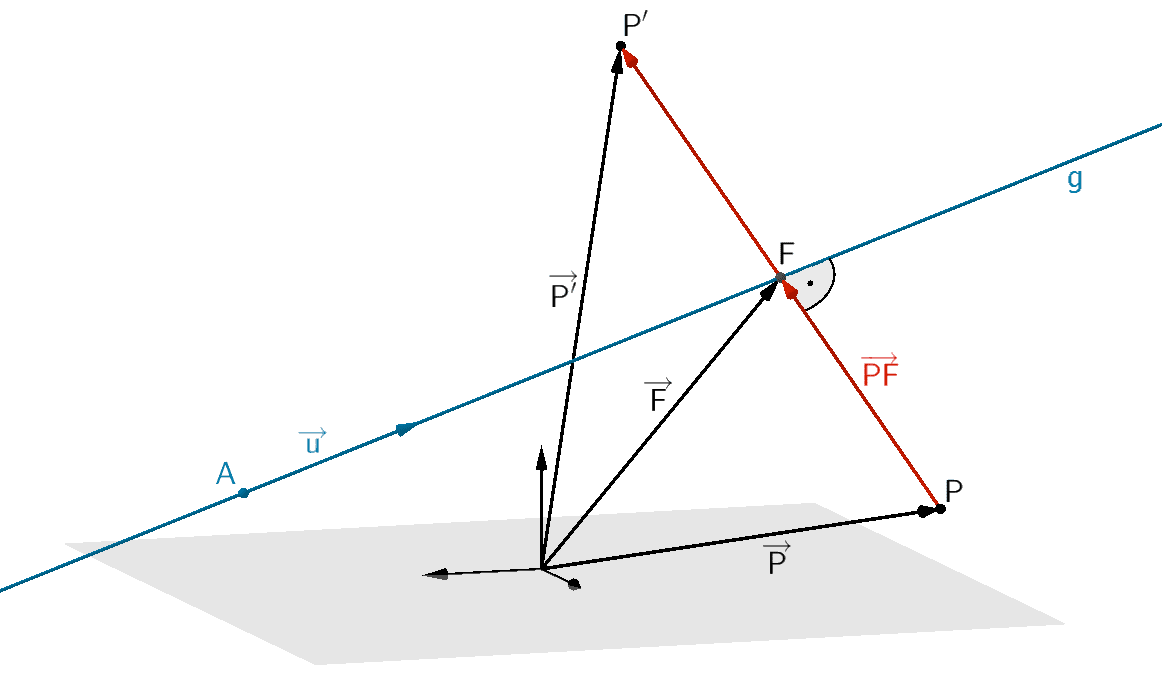
Es sei \(F\) der Lotfußpunkt des Lotes des Punktes \(P\) auf die Gerade \(g\). Die Entstehung des Bildpunktes \(P'\), der durch Spiegelung des Punktes \(P\) an der Gerade \(g \colon \overrightarrow{X} = \overrightarrow{A} + \lambda \cdot \overrightarrow{u}; \; \lambda \in \mathbb R\) hervorgeht, lässt sich auf die Spiegelung des Punktes \(P\) am Lotfußpunkt \(F\) zurückführen (vgl. Abiturskript - 2.6.1 Spiegelung eines Punktes an einem Punkt).
\[\overrightarrow{P'} = \overrightarrow{P} + 2 \cdot \overrightarrow{PF}\]
oder
\[\overrightarrow{P'} = \overrightarrow{F} + \overrightarrow{PF}\]
Es gibt mehrere Möglichkeiten, den Verbindungsvektor \(\overrightarrow{PF}\) bzw. den Lotfußpunkt \(F\) zu ermitteln (vgl. Abiturskript - 2.3.4 Lotgerade und orthogonale Ebene, Lotgerade zu einer Gerade und Abiturskript - 2.4.1 Abstand Punkt - Gerade).
1. Möglichkeit: Skalarprodukt orthogonaler (senkrechter) Vektoren anwenden
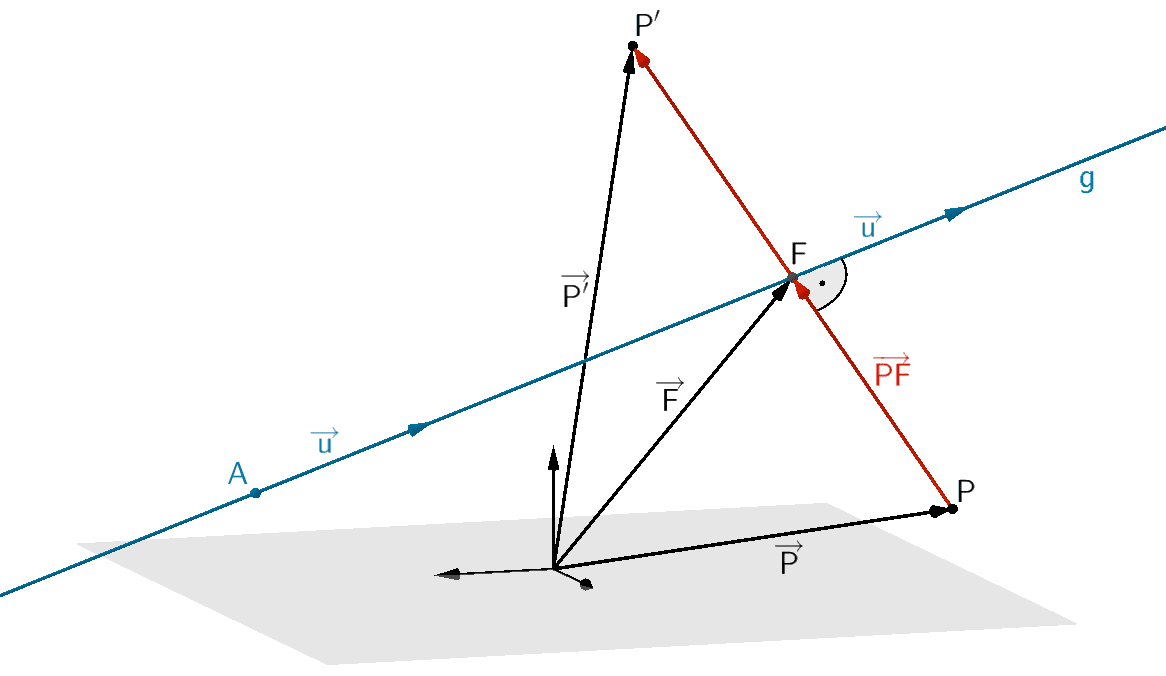
Der Richtungsvektor \(\overrightarrow{u}\) der Gerade \(g\) und der Verbindungsvektor \(\overrightarrow{PF}\) sind zueinander senkrecht. Folglich ist das Skalarprodukt beider Vektoren gleich Null (vgl. Abiturskript - 2.1.3 Skalarprodukt von Vektoren, Anwendungen des Skalarprodukts).
\[\overrightarrow{u} \perp \overrightarrow{PF} \quad \Longleftrightarrow \quad \overrightarrow{u} \circ \overrightarrow{PF} = 0\]
Der Verbindungsvektor \(\overrightarrow{PF}\) lässt sich in Abhängigkeit des Parameters \(\lambda\) der Gleichung der Gerade \(g\) beschreiben.
\[g \colon \overrightarrow{X} = \overrightarrow{A} + \lambda \cdot \overrightarrow{u}\,; \; \lambda \in \mathbb R\]
\[F \in g \colon \overrightarrow{F} = \overrightarrow{A} + \lambda \cdot \overrightarrow{u}\,; \; \lambda \in \mathbb R\]
\[\overrightarrow{PF} = \overrightarrow{F} - \overrightarrow{P} = \overrightarrow{A} + \lambda \cdot \overrightarrow{u} - \overrightarrow{P}\]
Wendet man das Skalarprodukt der beiden orthogonalen Vektoren \(\overrightarrow{u}\) und \(\overrightarrow{PF}\) an, liefert dies genau den Wert des Parameters \(\lambda\), der den Verbindungsvektor \(\overrightarrow{PF}\) und den Ortsvektor \(\overrightarrow{F}\) festlegt.
\[\begin{align*}\overrightarrow{u} \circ \overrightarrow{PF} &= 0 \\[0.8em] \overrightarrow{u} \circ (\overrightarrow{A} + \lambda \cdot \overrightarrow{u} - \overrightarrow{P}) &= 0 \end{align*}\]
\(\Longrightarrow \quad\)Parameterwert für \(\lambda\)
\(\Longrightarrow \quad \)Verbindungsvektor \(\overrightarrow{PF}\) und \(F \in g\)
2. Möglichkeit: Hilfsebene aufstellen
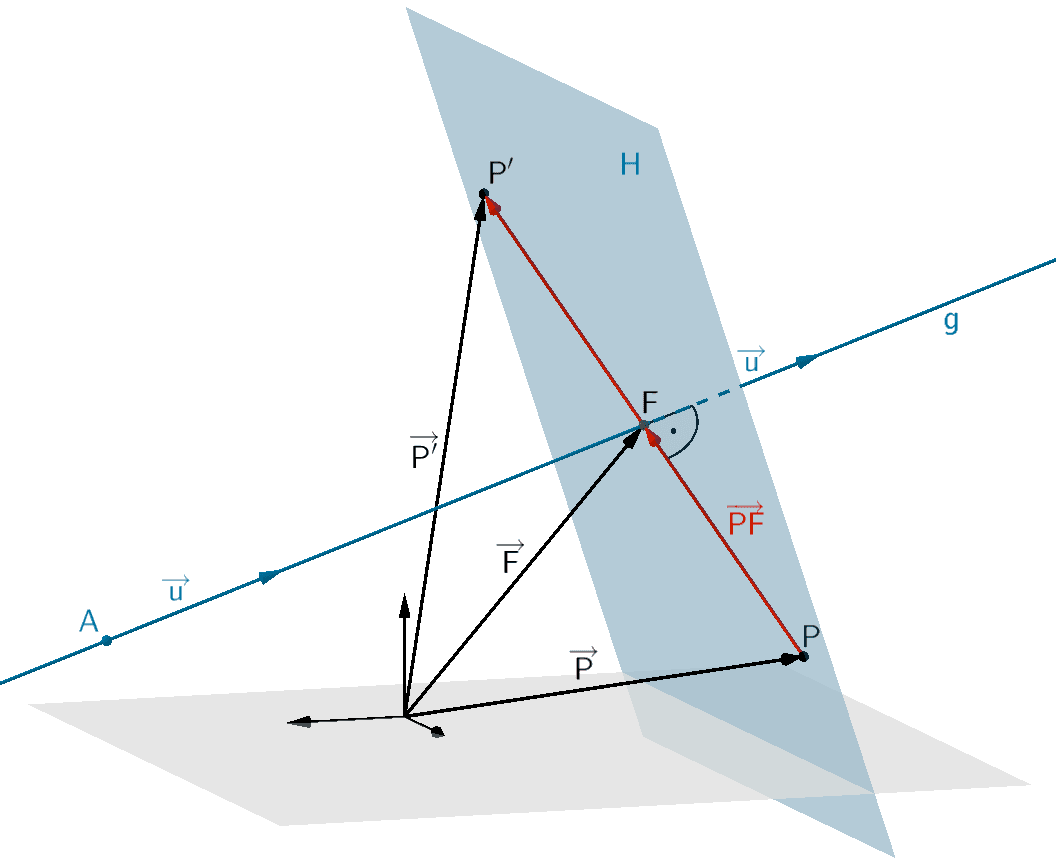
Die Hilfsebene \(H\) mit den Eigenschaften \(P \in H\) und \(g \perp H\) schneidet die Gerade \(g\) im Lotfußpunkt \(F\) des Lotes des Punktes \(P\) auf die Gerade \(g\).
Um den Verbindungsvektor \(\overrightarrow{PF}\) zu bestimmen, stellt man eine Hilfsebene \(H\) auf, welche den Punkt \(P\) enthält und senkrecht zur Gerade \(g\) liegt. Als Normalenvektor für die Gleichung der Hilfsebene \(H\) in Normalenform dient der Richtungsvektor \(\overrightarrow{u}\) der Geradengleichung von \(g\).
\[P \in H\]
\[g \perp H \quad \Longrightarrow \quad \overrightarrow{n}_{H} = \overrightarrow{u}\]
\[H \colon \overrightarrow{u} \circ (\overrightarrow{X} - \overrightarrow{P}) = 0\]
Der Verbindungsvektor \(\overrightarrow{PF}\) lässt sich in Abhängigkeit des Parameters \(\lambda\) der Gleichung der Gerade \(g\) beschreiben.
\[g \colon \overrightarrow{X} = \overrightarrow{A} + \lambda \cdot \overrightarrow{u}\,; \; \lambda \in \mathbb R\]
\[F \in g \colon \overrightarrow{F} = \overrightarrow{A} + \lambda \cdot \overrightarrow{u}\,; \; \lambda \in \mathbb R\]
\[\overrightarrow{PF} = \overrightarrow{F} - \overrightarrow{P} = \overrightarrow{A} + \lambda \cdot \overrightarrow{u} - \overrightarrow{P}\]
Schneidet man die Gerade \(g\) mit der Hilfsebene \(H\), erhält man genau den Wert des Parameters \(\lambda\), der den Verbindungsvektor \(\overrightarrow{PF}\) und den Ortsvektor \(\overrightarrow{F}\) festlegt (vgl. Abiturskript - 2.3.2 Lagebeziehung von Gerade und Ebene, Bestimmung des Schnittpunkts).
\[g \cap H \colon \overrightarrow{u} \circ (\overrightarrow{A} + \lambda \cdot \overrightarrow{u} - \overrightarrow{P}) = 0\]
\(\Longrightarrow \quad\)Parameterwert für \(\lambda\)
\(\Longrightarrow \quad \)Verbindungsvektor \(\overrightarrow{PF}\) und \(F \in g\)
3. Möglichkeit: Differentialrechnung anwenden (Extremwertaufgabe)
![Strecke [PX] zwischen dem Punkt P und einem beliebigen Punkt X ∈ g Strecke [PX] zwischen dem Punkt P und einem beliebigen Punkt X ∈ g](/images/stories/abi_check/geometrie/Spiegelung_Punkt_Gerade4.png)
Strecke \([PX]\) zwischen Punkt \(P\) und einem beliebigen Punkt \(X \in g\)
Es sei \(F\) der Lotfußpunkt des Lotes des Punktes \(P\) auf die Gerade \(g\).
Die Länge der Strecke \([PX]\) zwischen dem Punkt \(P\) und einem beliebigen Punkt \(X \in g\) ist gleich dem Betrag des Verbindungsvektors \(\overrightarrow{PX}\).
\[\overline{PX} = \vert \overrightarrow{PX} \vert\]
Der Verbindungsvektor \(\overrightarrow{PX}\) lässt sich in Abhängigkeit des Parameters \(\lambda\) der Gleichung der Gerade \(g\) beschreiben.
\[g \colon \overrightarrow{X} = \overrightarrow{A} + \lambda \cdot \overrightarrow{u}\,; \; \lambda \in \mathbb R\]
\[\overrightarrow{PX} = \overrightarrow{X} - \overrightarrow{P} = \overrightarrow{A} + \lambda \cdot \overrightarrow{u} - \overrightarrow{P}\]
Für \(X = F\) ist die Länge der Strecke \([PX]\) minimal. Folglich muss die erste Ableitung \(\overline{PX}'\) gleich Null sein (vgl. Abiturskript - 1.5.3 Monotonieverhalten, Extrem- und Terrassenpunkte und Abiturskript - 1.5.7 Extremwertaufgaben). Der Nachweis der Art des Extremwerts kann entfallen, denn für \(X \neq F\) nimmt die Länge der Strecke \([PX]\) einen beliebig großen Wert an. Somit existiert keine maximale Länge der Strecke \([PX]\).
Die Extremstelle \(\lambda_{min}\) liefert genau den Wert des Parameters \(\lambda\), der den Verbindungsvektor \(\overrightarrow{PF}\) und den Ortsvektor \(\overrightarrow{F}\) festlegt.
\[\overline{PX}'(\lambda) \overset{!}{=} 0\]
\(\Longrightarrow \quad\)Parameterwert für \(\lambda\)
\(\Longrightarrow \quad \)Verbindungsvektor \(\overrightarrow{PF}\) und \(F \in g\)
Beispielaufgabe
Gegeben seien die Punkte \(A(6|3|2)\), \(B(-6|3|6)\) und \(C(-2|-2|8)\), welche das Dreieck \(ABC\) festlegen. Durch Spiegelung des Punktes \(C\) an der Seite \([AB]\) entsteht das Drachenviereck \(AC'BC\).
Berechnen Sie die Koordinaten des Punktes \(C'\).
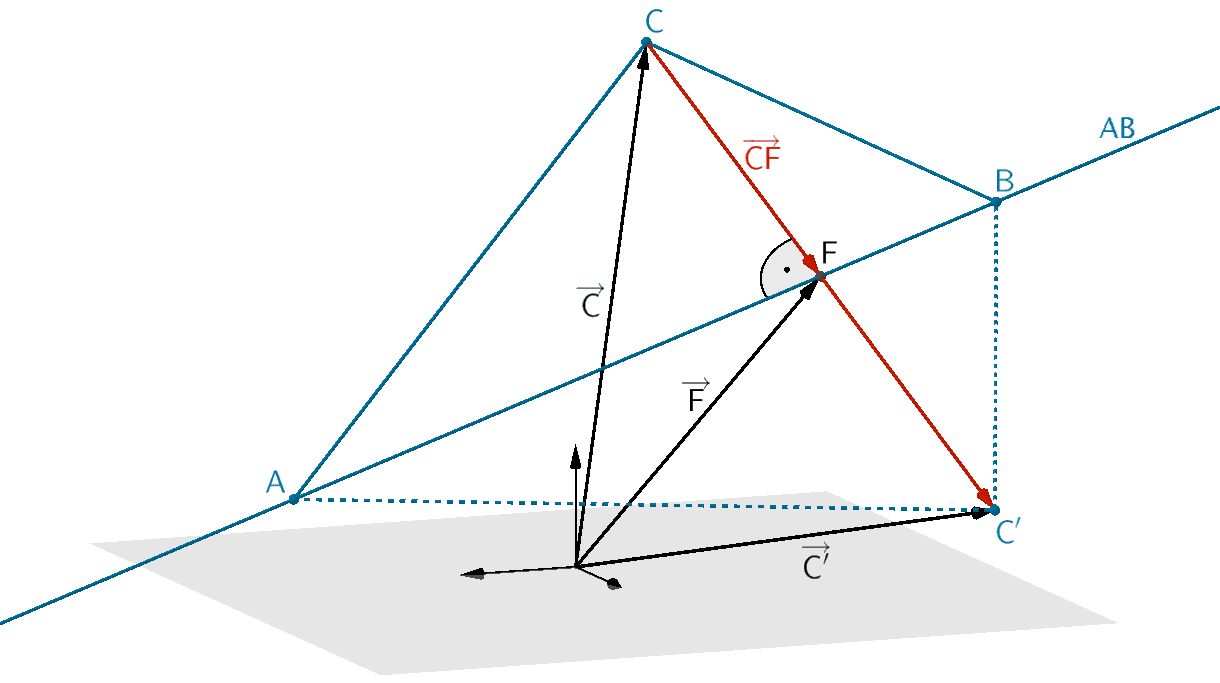
Es sei \(F\) der Lotfußpunkt des Lotes des Punktes \(C\) auf die Gerade \(AB\). Die Entstehung des Bildpunkts \(C'\), der durch Spiegelung des Punktes \(C\) an der Seite \([AB]\) bzw. an der Gerade \(AB\) hervorgeht, lässt sich auf die Spiegelung des Punktes \(C\) am Lotfußpunkt \(F\) zurückführen (vgl. Abiturskript - 2.6.1 Spiegelung eines Punktes an einem Punkt).
\[\overrightarrow{C'} = \overrightarrow{C} + 2 \cdot \overrightarrow{CF}\]
oder
\[\overrightarrow{C'} = \overrightarrow{F} + \overrightarrow{CF}\]
Es gibt mehrere Möglichkeiten, den Verbindungsvektor \(\overrightarrow{CF}\) bzw. den Lotfußpunkt \(F\) zu ermitteln (vgl. Abiturskript - 2.3.4 Lotgerade und orthogonale Ebene, Lotgerade zu einer Gerade und Abiturskript - 2.4.1 Abstand Punkt - Gerade).
1. Möglichkeit: Skalarprodukt orthogonaler (senkrechter) Vektoren anwenden
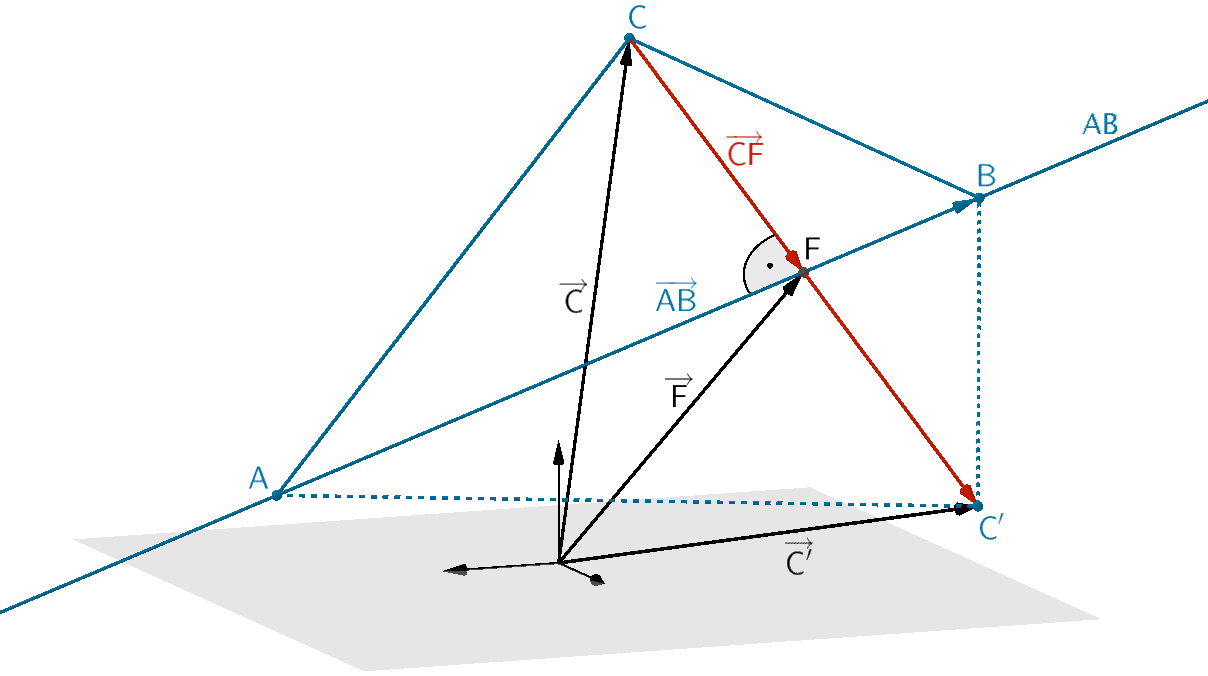
Es sei \(F\) der Lotfußpunkt des Lotes des Punktes \(C\) auf die Gerade \(AB\).
Der Verbindungsvektor \(\overrightarrow{AB}\) (oder ein Vielfaches davon) ist ein Richtungsvektor \(\overrightarrow{u}\) der Geraden \(AB\). Der Richtungsvektor der Gerade \(AB\) und der Verbindungsvektor \(\overrightarrow{CF}\) sind zueinander senkrecht. Folglich ist das Skalarprodukt der Vektoren gleich Null.(vgl. Abiturskript - 2.1.3 Skalarprodukt von Vektoren, Anwendungen des Skalarprodukts).
\[\overrightarrow{AB} \perp \overrightarrow{CF} \quad \Longleftrightarrow \quad \overrightarrow{AB} \circ \overrightarrow{CF} = 0\]
bzw.
\[\overrightarrow{u} \perp \overrightarrow{CF} \quad \Longleftrightarrow \quad \overrightarrow{u} \circ \overrightarrow{CF} = 0\]
Gleichung der Gerade \(AB\) aufstellen:
\(A(6|3|2)\), \(B(-6|3|6)\)
\[AB \colon \overrightarrow{X} = \overrightarrow{A} + \lambda \cdot \overrightarrow{u}; \; \lambda \in \mathbb R\]
\[\overrightarrow{AB} = \overrightarrow{B} - \overrightarrow{A} = \begin{pmatrix} -6 \\ 3 \\ 6 \end{pmatrix} - \begin{pmatrix} 6 \\ 3 \\ 2 \end{pmatrix} = \begin{pmatrix} -12 \\ 0 \\ 4 \end{pmatrix} = 4 \cdot \begin{pmatrix} -3 \\ 0 \\ 1 \end{pmatrix}\]
\[\Longrightarrow \quad \overrightarrow{u} = \begin{pmatrix} -3 \\ 0 \\ 1 \end{pmatrix}\]
\[\Longrightarrow \quad AB \colon \overrightarrow{X} = \begin{pmatrix} 6 \\ 3 \\ 2 \end{pmatrix} + \lambda \cdot \begin{pmatrix} -3 \\ 0 \\ 1 \end{pmatrix}; \; \lambda \in \mathbb R\]
Verbindungsvektor \(\overrightarrow{CF}\) in Abhängigkeit des Parameters \(\lambda\) der Gleichung der Gerade \(AB\) beschreiben:
\[C(-2|-2|8)\]
\[F \in AB \colon \overrightarrow{F} = \begin{pmatrix} 6 \\ 3 \\ 2 \end{pmatrix} + \lambda \cdot \begin{pmatrix} -3 \\ 0 \\ 1 \end{pmatrix} = \begin{pmatrix} 6 - 3\lambda \\ 3 \\ 2 + \lambda \end{pmatrix}\]
\[\overrightarrow{CF} = \overrightarrow{F} - \overrightarrow{C} = \begin{pmatrix} 6 - 3\lambda \\ 3 \\ 2 + \lambda \end{pmatrix} - \begin{pmatrix} -2 \\ -2 \\ 8 \end{pmatrix} = \begin{pmatrix} 8 - 3\lambda \\ 5 \\ -6 + \lambda \end{pmatrix}\]
Skalarprodukt der ortogonalen Vektoren \(\overrightarrow{u}\) und \(\overrightarrow{CF}\) anwenden (vgl. Abiturskript - 2.1.3 Skalarprodukt von Vektoren, Anwendungen des Skalarprodukts):
\[\begin{align*}\overrightarrow{u} \circ \overrightarrow{CF} &= 0 \\[0.8em] \begin{pmatrix} -3 \\ 0 \\ 1 \end{pmatrix} \circ \begin{pmatrix} 8 - 3\lambda \\ 5 \\ -6 + \lambda \end{pmatrix} &= 0 \\[0.8em] (-3) \cdot (8 - 3\lambda) + 0 \cdot 5 + 1 \cdot (-6 + \lambda) &= 0 \\[0.8em] -24 + 9\lambda - 6 + \lambda &= 0 \\[0.8em] -30 + 10\lambda &= 0 & &| + 30 \\[0.8em] 10\lambda &= 30 & &| : 10 \\[0.8em] \lambda &= 3 \end{align*}\]
Verbindungsvektor \(\overrightarrow{CF}\) und ggf. Ortsvektor \(\overrightarrow{F}\) berechnen:
\[\overrightarrow{CF} = \begin{pmatrix} 8 - 3\lambda \\ 5 \\ -6 + \lambda \end{pmatrix} = \begin{pmatrix} 8 - 3 \cdot 3 \\ 5 \\ -6 + 3 \end{pmatrix} = \begin{pmatrix} -1 \\ 5 \\ -3 \end{pmatrix}\]
\[F \in AB \colon \overrightarrow{F} = \begin{pmatrix} 6 \\ 3 \\ 2 \end{pmatrix} + 3 \cdot \begin{pmatrix} -3 \\ 0 \\ 1 \end{pmatrix} = \begin{pmatrix} -3 \\ 3 \\ 5 \end{pmatrix}\]
Koordinaten des Punktes \(C'\) berechnen:
\[\overrightarrow{C'} = \overrightarrow{C} + 2 \cdot \overrightarrow{CF} = \begin{pmatrix} -2 \\ -2 \\ 8 \end{pmatrix} + 2 \cdot \begin{pmatrix} -1 \\ 5 \\ -3 \end{pmatrix} = \begin{pmatrix} -4 \\ 8 \\ 2 \end{pmatrix}\]
oder
\[\overrightarrow{C'} = \overrightarrow{F} + \overrightarrow{CF} = \begin{pmatrix} -3 \\ 3 \\ 5 \end{pmatrix} + \begin{pmatrix} -1 \\ 5 \\ -3 \end{pmatrix} = \begin{pmatrix} -4 \\ 8 \\ 2 \end{pmatrix}\]
\[\Longrightarrow \quad C'(-4|8|2)\]
2. Möglichkeit: Hilfsebene aufstellen
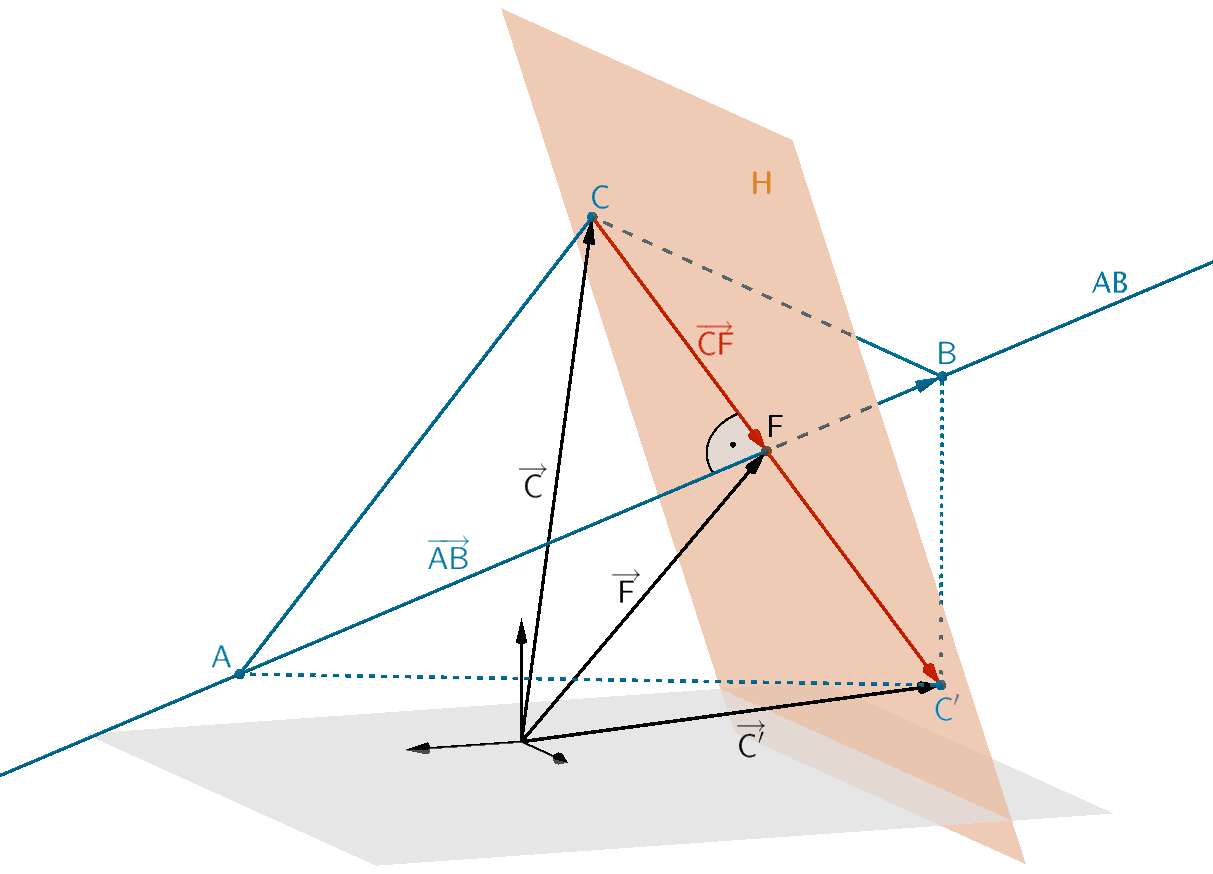
Es sei \(F\) der Lotfußpunkt des Lotes des Punktes \(C\) auf die Gerade \(AB\).
Die Hilfsebene \(H\) mit den Eigenschaften \(C \in H\) und \(AB \perp H\) schneidet die Gerade \(AB\) im Lotfußpunkt \(F\).
Gleichung der Gerade \(AB\) aufstellen:
\(A(6|3|2)\), \(B(-6|3|6)\)
\[AB \colon \overrightarrow{X} = \overrightarrow{A} + \lambda \cdot \overrightarrow{u}\,; \; \lambda \in \mathbb R\]
\[\overrightarrow{AB} = \overrightarrow{B} - \overrightarrow{A} = \begin{pmatrix} -6 \\ 3 \\ 6 \end{pmatrix} - \begin{pmatrix} 6 \\ 3 \\ 2 \end{pmatrix} = \begin{pmatrix} -12 \\ 0 \\ 4 \end{pmatrix} = 4 \cdot \begin{pmatrix} -3 \\ 0 \\ 1 \end{pmatrix}\]
\[\Longrightarrow \quad \overrightarrow{u} = \begin{pmatrix} -3 \\ 0 \\ 1 \end{pmatrix}\]
\[\Longrightarrow \quad AB \colon \overrightarrow{X} = \begin{pmatrix} 6 \\ 3 \\ 2 \end{pmatrix} + \lambda \cdot \begin{pmatrix} -3 \\ 0 \\ 1 \end{pmatrix}; \; \lambda \in \mathbb R\]
Gleichung der Hilfsebene \(H\) aufstellen:
\[C(-2|-2|8)\]
\[AB \colon \overrightarrow{X} = \begin{pmatrix} 6 \\ 3 \\ 2 \end{pmatrix} + \lambda \cdot \begin{pmatrix} -3 \\ 0 \\ 1 \end{pmatrix}; \; \lambda \in \mathbb R\]
\[C \in H, \, AB \perp H \]
\[H \colon \overrightarrow{u} \circ (\overrightarrow{X} - \overrightarrow{C}) = 0\]
\[H \colon \begin{pmatrix} -3 \\ 0 \\ 1 \end{pmatrix} \circ \left[ \overrightarrow{X} - \begin{pmatrix} -2 \\ -2 \\ 8 \end{pmatrix} \right] = 0\]
\[\begin{align*} \begin{pmatrix} -3 \\ 0 \\ 1 \end{pmatrix} \circ \left[ \overrightarrow{X} - \begin{pmatrix} -2 \\ -2 \\ 8 \end{pmatrix} \right] &= 0 \\[0.8em] (-3) \cdot (x_{1} + 2) + 0 \cdot (x_{2} + 2) + 1 \cdot (x_{3} - 8) &= 0 \\[0.8em] -3x_{1} - 6 + x_{3} - 8 &= 0 \\[0.8em] -3x_{1} + x_{3} - 14 &= 0 \end{align*}\]
\[H \colon -3x_{1} + x_{3} - 14 = 0\]
Verbindungsvektor \(\overrightarrow{CF}\) in Abhängigkeit des Parameters \(\lambda\) der Gleichung der Gerade \(AB\) beschreiben:
\[C(-2|-2|8)\]
\[F \in AB \colon \overrightarrow{F} = \begin{pmatrix} 6 \\ 3 \\ 2 \end{pmatrix} + \lambda \cdot \begin{pmatrix} -3 \\ 0 \\ 1 \end{pmatrix} = \begin{pmatrix} 6 - 3\lambda \\ 3 \\ 2 + \lambda \end{pmatrix}\]
\[\overrightarrow{CF} = \overrightarrow{F} - \overrightarrow{C} = \begin{pmatrix} 6 - 3\lambda \\ 3 \\ 2 + \lambda \end{pmatrix} - \begin{pmatrix} -2 \\ -2 \\ 8 \end{pmatrix} = \begin{pmatrix} 8 - 3\lambda \\ 5 \\ -6 + \lambda \end{pmatrix}\]
Gerade \(AB\) mit der Hilfsebene H schneiden (vgl. Abiturskript - 2.3.2 Lagebeziehung von Gerade und Ebene, Bestimmung des Schnittpunkts):
\[AB \colon \overrightarrow{X} = \begin{pmatrix} 6 \\ 3 \\ 2 \end{pmatrix} + \lambda \cdot \begin{pmatrix} -3 \\ 0 \\ 1 \end{pmatrix}; \; \lambda \in \mathbb R\]
\[H \colon -3x_{1} + x_{3} - 14 = 0\]
\[\begin{align*} AB \cap H \colon (-3) \cdot (6 - 3\lambda) + 2 + \lambda - 14 &= 0 \\[0.8em] -18 + 9\lambda + 2 + \lambda - 14 &= 0 \\[0.8em] -30 + 10\lambda &= 0 & &| + 30 \\[0.8em] 10\lambda &= 30 & &| : 10 \\[0.8em] \lambda &= 3 \end{align*}\]
Verbindungsvektor \(\overrightarrow{CF}\) und ggf. Ortsvektor \(\overrightarrow{F}\) berechnen:
\[\overrightarrow{CF} = \begin{pmatrix} 8 - 3\lambda \\ 5 \\ -6 + \lambda \end{pmatrix} = \begin{pmatrix} 8 - 3 \cdot 3 \\ 5 \\ -6 + 3 \end{pmatrix} = \begin{pmatrix} -1 \\ 5 \\ -3 \end{pmatrix}\]
\[F \in AB \colon \overrightarrow{F} = \begin{pmatrix} 6 \\ 3 \\ 2 \end{pmatrix} + 3 \cdot \begin{pmatrix} -3 \\ 0 \\ 1 \end{pmatrix} = \begin{pmatrix} -3 \\ 3 \\ 5 \end{pmatrix}\]
Koordinaten des Punktes \(C'\) berechnen:
\[\overrightarrow{C'} = \overrightarrow{C} + 2 \cdot \overrightarrow{CF} = \begin{pmatrix} -2 \\ -2 \\ 8 \end{pmatrix} + 2 \cdot \begin{pmatrix} -1 \\ 5 \\ -3 \end{pmatrix} = \begin{pmatrix} -4 \\ 8 \\ 2 \end{pmatrix}\]
oder
\[\overrightarrow{C'} = \overrightarrow{F} + \overrightarrow{CF} = \begin{pmatrix} -3 \\ 3 \\ 5 \end{pmatrix} + \begin{pmatrix} -1 \\ 5 \\ -3 \end{pmatrix} = \begin{pmatrix} -4 \\ 8 \\ 2 \end{pmatrix}\]
\[\Longrightarrow \quad C'(-4|8|2)\]
3. Möglichkeit: Differentialrechnung anwenden (Extremwertaufgabe)
![Strecke [CX] zwischen dem Punkt C und einem beliebigen Punkt X ∈ AB Strecke [CX] zwischen dem Punkt C und einem beliebigen Punkt X ∈ AB](/images/stories/abi_check/geometrie/Spiegelung_Punkt_Gerade_Bsp4.png)
Es sei \(F\) der Lotfußpunkt des Lotes des Punktes \(C\) auf die Gerade \(AB\).
Die Länge der Strecke \([CX]\) zwischen dem Punkt \(C\) und einem beliebigen Punkt \(X \in AB\) ist gleich dem Betrag des Verbindungsvektors \(\overrightarrow{CX}\).
\[\overline{CX} = \vert \overrightarrow{CX} \vert\]
Für \(X = F\) ist die Länge der Strecke \([CX]\) minimal. Folglich muss die erste Ableitung \(\overline{CX}'\) gleich Null sein (vgl. Abiturskript - 1.5.3 Monotonieverhalten, Extrem- und Terrassenpunkte und Abiturskript - 1.5.7 Extremwertaufgaben).
\[\overline{CX}'(\lambda) \overset{!}{=} 0\]
Gleichung der Gerade \(AB\) aufstellen:
\(A(6|3|2)\), \(B(-6|3|6)\)
\[AB \colon \overrightarrow{X} = \overrightarrow{A} + \lambda \cdot \overrightarrow{u}\,; \; \lambda \in \mathbb R\]
\[\overrightarrow{AB} = \overrightarrow{B} - \overrightarrow{A} = \begin{pmatrix} -6 \\ 3 \\ 6 \end{pmatrix} - \begin{pmatrix} 6 \\ 3 \\ 2 \end{pmatrix} = \begin{pmatrix} -12 \\ 0 \\ 4 \end{pmatrix} = 4 \cdot \begin{pmatrix} -3 \\ 0 \\ 1 \end{pmatrix}\]
\[\Longrightarrow \quad \overrightarrow{u} = \begin{pmatrix} -3 \\ 0 \\ 1 \end{pmatrix}\]
\[\Longrightarrow \quad AB \colon \overrightarrow{X} = \begin{pmatrix} 6 \\ 3 \\ 2 \end{pmatrix} + \lambda \cdot \begin{pmatrix} -3 \\ 0 \\ 1 \end{pmatrix}; \; \lambda \in \mathbb R\]
Verbindungsvektor \(\overrightarrow{CX}\) in Abhängigkeit des Parameters \(\lambda\) der Gleichung der Gerade \(AB\) beschreiben:
\[C(-2|-2|8)\]
\[AB \colon \overrightarrow{X} = \begin{pmatrix} 6 \\ 3 \\ 2 \end{pmatrix} + \lambda \cdot \begin{pmatrix} -3 \\ 0 \\ 1 \end{pmatrix} = \begin{pmatrix} 6 - 3\lambda \\ 3 \\ 2 + \lambda \end{pmatrix}\]
\[\overrightarrow{CX} = \overrightarrow{X} - \overrightarrow{C} = \begin{pmatrix} 6 - 3\lambda \\ 3 \\ 2 + \lambda \end{pmatrix} - \begin{pmatrix} -2 \\ -2 \\ 8 \end{pmatrix} = \begin{pmatrix} 8 - 3\lambda \\ 5 \\ -6 + \lambda \end{pmatrix}\]
Länge der Strecke \([CX]\) in Abhängigkeit des Parameters \(\lambda\) formulieren:
\[\begin{align*} \overline{CX} &= \vert \overrightarrow{CX} \vert \\[0.8em] &= \left| \begin{pmatrix} 8 - 3\lambda \\ 5 \\ -6 + \lambda \end{pmatrix} \right| \\[0.8em] &= \sqrt{(8 - 3\lambda)^{2} + 5^{2} + (-6 + \lambda)^{2}} \\[0.8em] &= \sqrt{64 - 48\lambda + 9\lambda^{2} + 25 + 36 - 12\lambda + \lambda^{2}} \\[0.8em] &= \sqrt{10\lambda^{2} - 60\lambda + 125} \end{align*}\]
Notwendige Bedingung \(\overline{CX}'(\lambda) = 0\) für minimale Länge der Strecke \([CX]\) (vgl. Abiturskript - 1.5.2 Ableitungsregeln):
\[\begin{align*} \overline{CX}'(\lambda) &= 0 \\[0.8em] \left( \sqrt{10\lambda^{2} - 60\lambda + 125} \right)' &= 0 \\[0.8em] \frac{20\lambda - 60}{2 \cdot \sqrt{10\lambda^{2} - 60\lambda + 125}} &= 0 \end{align*}\]
\[\begin{align*}\Longrightarrow \quad 20\lambda - 60 &= 0 & &| + 60 \\[0.8em] 20\lambda &= 60 & &| : 20 \\[0.8em] \lambda &= 3\end{align*}\]
Verbindungsvektor \(\overrightarrow{CF}\) und ggf. Ortsvektor \(\overrightarrow{F}\) berechnen:
\[\overrightarrow{CF} = \begin{pmatrix} 8 - 3\lambda \\ 5 \\ -6 + \lambda \end{pmatrix} = \begin{pmatrix} 8 - 3 \cdot 3 \\ 5 \\ -6 + 3 \end{pmatrix} = \begin{pmatrix} -1 \\ 5 \\ -3 \end{pmatrix}\]
\[F \in AB \colon \overrightarrow{F} = \begin{pmatrix} 6 \\ 3 \\ 2 \end{pmatrix} + 3 \cdot \begin{pmatrix} -3 \\ 0 \\ 1 \end{pmatrix} = \begin{pmatrix} -3 \\ 3 \\ 5 \end{pmatrix}\]
Koordinaten des Punktes \(C'\) berechnen:
\[\overrightarrow{C'} = \overrightarrow{C} + 2 \cdot \overrightarrow{CF} = \begin{pmatrix} -2 \\ -2 \\ 8 \end{pmatrix} + 2 \cdot \begin{pmatrix} -1 \\ 5 \\ -3 \end{pmatrix} = \begin{pmatrix} -4 \\ 8 \\ 2 \end{pmatrix}\]
oder
\[\overrightarrow{C'} = \overrightarrow{F} + \overrightarrow{CF} = \begin{pmatrix} -3 \\ 3 \\ 5 \end{pmatrix} + \begin{pmatrix} -1 \\ 5 \\ -3 \end{pmatrix} = \begin{pmatrix} -4 \\ 8 \\ 2 \end{pmatrix}\]
\[\Longrightarrow \quad C'(-4|8|2)\]


